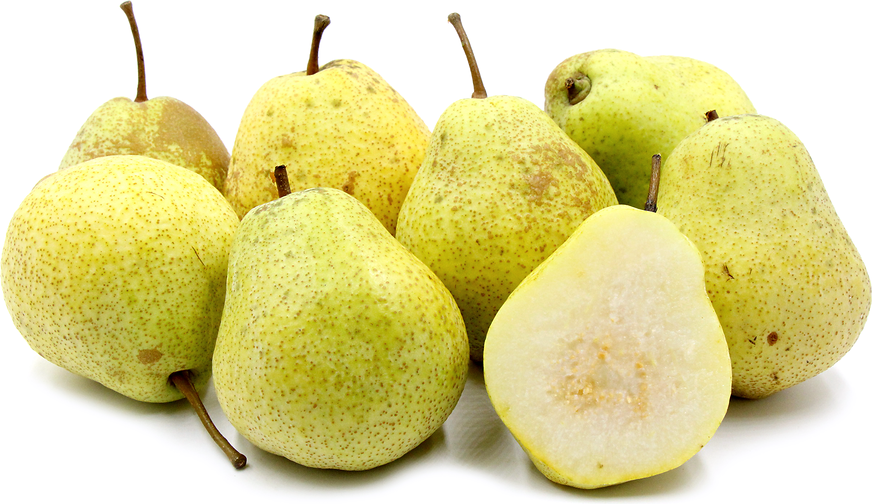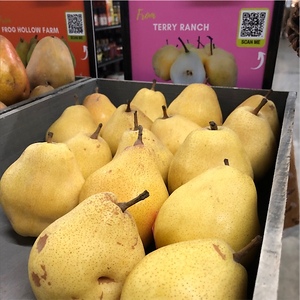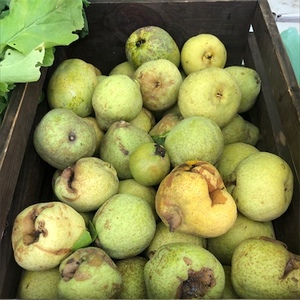


Kieffer Pears
Estimated Inventory, 1 Lb : 0
Description/Taste
Kieffer pears are medium to large fruits, averaging 5 to 10 centimeters in diameter, and have an elongated, oval shape with a bulbous center that tapers slightly at both ends. The fruits feel heavy for their size and have semi-thick, smooth, and firm skin, ripening from green to golden yellow when ripe. The skin may also bear crimson blush on one side of the fruit and be covered in many small, dark brown lenticels giving the skin a lightly textured feel. Underneath the surface, the flesh is pale yellow to white, crisp, dense, aqueous, and coarse, encasing a central core filled with small, black-brown seeds. Kieffer pears have a faint, fruity, and musky aroma with a mild, sweet, and subtly tart flavor. It is important to note that the fruit’s flavor improves after extended storage and is considered ripe when the flesh around the neck gives slightly under pressure. Even when ripe, the flesh will soften but will also retain a crisp quality.
Seasons/Availability
Kieffer pears are available in the fall through winter.
Current Facts
Kieffer pears, botanically a member of the Pyrus genus, are a hybrid variety of a European bartlett pear crossed with an Asian sand pear, belonging to the Rosaceae family. The American heirloom was first discovered in the late 19th century, growing as a chance seedling, and quickly became famous for its extended storage capabilities. Growers also favored Kieffer pear trees for its resistance to disease, hardy nature, and high yields, often planted along property lines of farms as a living fence. Despite their momentary fame, Kieffer pears quickly fell out of favor due to their long chilling period, preventing consumers from being able to use the fruits immediately. In the modern-day, Kieffer pears are grown by specialty farms as a novel variety and are localized to farmer’s markets. The pears are also seen growing on many ranches, plantations, and gardens across the United States, used by home chefs for canning, baking, and fresh eating.
Nutritional Value
Kieffer pears are a good source of vitamin C to strengthen the immune system and provide adequate fiber levels to regulate the digestive tract. The fruits also contain copper to maintain healthy nerve functioning, potassium to balance fluid levels in the body, and vitamin K to assist in wound healing.
Applications
Kieffer pears are best suited for cooked applications, including baking, boiling, and poaching. The fruits can be consumed fresh, but they must be fully ripened over several weeks to be considered palatable for eating. Kieffer pears are most commonly used in preserved or canned preparations, as the flesh holds its shape well and retains a crisp consistency. The pears can also be cooked into sauces with honey, sugar, or lemon and served with roasted meats, baked into cakes, tarts, pies, muffins, bread, and popovers, made into jams, marmalade, honey, and chutney, or sliced into thin pieces and dried for extended use. Kieffer pears complement ingredients such as honey, lemon juice, vanilla, brown sugar, spices such as cinnamon, allspice, and nutmeg, celery, parsnips, persimmons, apples, cheeses such as blue, gorgonzola, and brie, and nuts such as pecans, walnuts, and almonds. Whole, unwashed Kieffer pears should be left 2 to 3 weeks in a cool, dry, and dark location to ripen. Once mature, the pears can be consumed fresh or stored in the refrigerator for an additional couple of weeks.
Ethnic/Cultural Info
Kieffer pears evoke a sense of nostalgia for residents of the Southern United States. The hardy, adaptable trees were one of the only pear varieties to withstand fireblight in the humid South during the 19th and early 20th centuries, leading it to become one of the most popular fruit trees planted in states such as Louisiana, Texas, and Georgia. Kieffer pear trees also became a symbol of a family plantation or ranch. The trees would be planted beside the home, and the fruits were favored for their extended storage capabilities since food preservation options were limited at the time. Kieffer pears were primarily canned or cooked into preserves, traditionally served over biscuits, but they were sometimes left to ripen and were consumed fresh. In the present-day, there are many Kieffer pear trees found throughout the South that have been abandoned and are still growing, and these trees remain a visual of the region’s past. In Wimberley, Texas, Chef Matthew Buchanan used this historical symbol to name his restaurant, The Leaning Pear, after a Kieffer pear tree that thrived in a rocky pasture on his family ranch. Buchanan harvests the fruits from his Kieffer pear tree and incorporates the variety into his fall seasonal menu in salads, pear and apple crisps, and soups.
Geography/History
Kieffer pears were discovered as a chance seedling in an orchard in Roxborough, a neighborhood in Northwest Philadelphia, in 1863. Grower Peter Kieffer had a small nursery where he cultivated Asian sand pears and European bartlett pears, and one day he noticed a small seedling that had a different appearance from the rest of his trees. Kieffer continued to care for the tree until it began producing fruit and discovered that it was an accidental cross between a sand and bartlett pear. The new variety was introduced at the Centennial Exposition in 1876 under the name Kieffer, officially named after its founder, and was recognized as a distinct variety by the American Pomological Society in 1883. Today Kieffer pear trees are found thriving in a wide range of climates, ranging from New England to the southern United States, and are predominately grown through small farms, sold at farmer's markets, and through specialty grocers in the United States and Canada.
Recipe Ideas
Recipes that include Kieffer Pears. One
| Food 52 |
|
Pear and Black Pepper Preserves |
| 417 Magazine |
|
Brown Butter Riesling Poached Kieffer Pear Tart |
| Good Life Eats |
|
Homemade Pearsauce |
| Taste of Home |
|
Fresh Pear Bread |
| Gimme Some Oven |
|
Easy Pear Butter |
















